Troy-Bilt TB 33 LS Deluxe User Manual
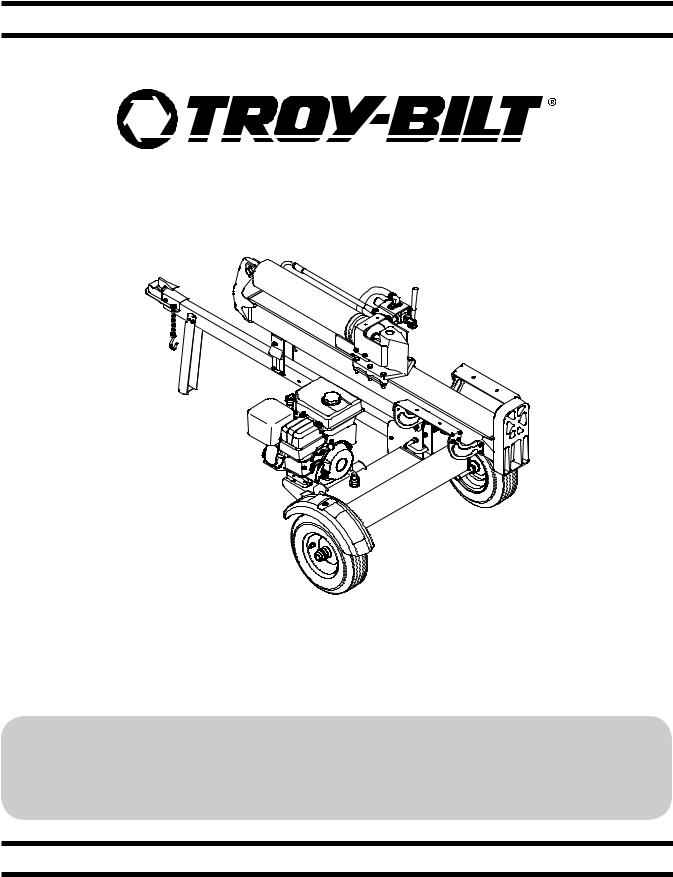
Safe Operation Practices • Set-Up • Operation • Maintenance • Service • Troubleshooting • Warranty
Operator’s Manual
LS 33 TB — Log Splitter
 WARNING
WARNING
READ AND FOLLOW ALL SAFETY RULES AND INSTRUCTIONS IN THIS MANUAL
BEFORE ATTEMPTING TO OPERATE THIS MACHINE.
FAILURE TO COMPLY WITH THESE INSTRUCTIONS MAY RESULT IN PERSONAL INJURY.
TROY-BILT LLC, P.O. BOX 361131 CLEVELAND, OHIO 44136-0019
Printed In USA |
Form No. 769-09924 |
|
(May 27, 2014) |

To The Owner
Thank You
Thank you for purchasing a Troy-Bilt Log Splitter. It was carefully engineered to provide excellent performance when properly operated and maintained.
Please read this entire manual prior to operating the equipment. It instructs you how to safely and easily set up, operate and maintain your machine. Please be sure that you, and any other persons who will operate the machine, carefully follow the recommended safety practices at all times. Failure to do so could result in personal injury or property damage.
All information in this manual is relative to the most recent product information available at the time of printing. Review this manual frequently to familiarize yourself with the machine, its features and operation. Please be aware that this Operator’s Manual may cover a range of product specifications for various models. Characteristics and features discussed and/or illustrated in this manual may not be applicable to all models. We reserve the right to change product specifications, designs and equipment without notice and without incurring obligation.
1
If applicable, the power testing information used to establish the power rating of the engine equipped on this machine can be found at www.opei.org or the engine manufacturer’s web site.
If you have any problems or questions concerning the machine, phone a authorized Troy-Bilt service dealer or contact us directly. Troy-Bilt’s Customer Support telephone numbers, website address and mailing address can be found on this page. We want to ensure your complete satisfaction at all times.
Throughout this manual, all references to right and left side of the machine are observed from the operating position
Table of Contents
Safe Operation Practices......................................... |
3 |
Service...................................................................... |
16 |
Assembly & Set-Up................................................... |
7 |
Troubleshooting...................................................... |
17 |
Controls & Features................................................ |
11 |
Replacement Parts.................................................. |
19 |
Operation................................................................ |
12 |
Warranty................................................................. |
20 |
Maintenance & Adjustment.................................. |
15 |
|
|
Record Product Information |
Model Number |
|
|
|
|
|
|
|
|
|||||||||
Before setting up and operating your new equipment, please |
|
|
|
|
|
|
|
|
|
|
|
|
|
|
|
|
|
|
|
|
|
|
|
|
|
|
|
|
|
|
|
|
|
|
|
||
locate the model plate on the equipment and record the |
|
|
|
|
|
|
|
|
|
|
|
|
|
|
|
|
|
|
information in the provided area to the right. You can locate the |
|
|
|
|
|
|
|
|
|
|
|
|
|
|
|
|
|
|
|
|
|
|
|
|
|
|
|
|
|
|
|
|
|
|
|
||
model plate by standing at the operator’s position and looking |
Serial Number |
|
|
|
|
|
|
|
|
|||||||||
down at the top of the reservoir tank behind the engine. This |
|
|
|
|
|
|
|
|
||||||||||
information will be necessary, should you seek technical support |
|
|
|
|
|
|
|
|
||||||||||
|
|
|
|
|
|
|
|
|
||||||||||
via our web site, Customer Support Department, or with a local |
|
|
|
|
|
|
|
|
|
|
|
|
|
|
|
|
|
|
|
|
|
|
|
|
|
|
|
|
|
|
|
|
|
|
|
||
authorized service dealer. |
|
|
|
|
|
|
|
|
|
|
|
|
|
|
|
|
|
|
|
|
|
|
|
|
|
|
|
|
|
|
|
|
|
|
|
|
|
|
|
|
|
|
|
|
|
|
|
|
|
|
|
|
|
|
|
|
Customer Support
Please do NOT return the machine to the retailer or dealer without first contacting the Customer Support Department.
If you have difficulty assembling this product or have any questions regarding the controls, operation, or maintenance of this machine, you can seek help from the experts. Choose from the options below:
◊Visit us on the web at www.troybilt.com
See How-to Maintenance and Parts Installation Videos at www.troybilt.com/tutorials
◊Call a Customer Support Representative at (800) 828-5500 or (330) 558-7220
◊Write to Troy-Bilt LLC • P.O. Box 361131 • Cleveland, OH • 44136-0019
2

Important Safe Operation Practices |
2 |
|
|
|
|
WARNING! This symbol points out important safety instructions which, if not followed, could endanger the personal safety and/or property of yourself and others. Read and follow all instructions in this manual before attempting to operate this machine. Failure to comply with these instructions may result in personal injury.
When you see this symbol. HEED ITS WARNING!
CALIFORNIA PROPOSITION 65
WARNING! Engine Exhaust, some of its constituents, and certain vehicle components contain or emit chemicals known to State of California to cause cancer and birth defects or other reproductive harm.
DANGER! This machine was built to be operated according to the safe operation practices in this manual. As with any type of power equipment, carelessness or error on the part of the operator can result in serious injury. This machine is capable of amputating hands and feet and throwing debris. Failure to observe the following safety instructions could result in serious injury or death.
Training
1.Read, understand, and follow all instructions on the machine and in the manual(s) before attempting to assemble and operate. Keep this manual in a safe place for future and regular reference and for ordering replacement parts.
2.Be familiar with all controls and their proper operation. Know how to stop the machine and disengage them quickly.
3.Never allow children under 16 years of age to operate this machine. Children 16 and over should read and understand the instructions and safe operation practices in this manual and on the machine and be trained and supervised by an adult.
4.Never allow adults to operate this machine without proper instruction.
5.Many accidents occur when more than one person operates the machine. If a helper is assisting in stacking logs, never activate the control until the helper is a minimum of 10 feet from the machine.
6.Keep bystanders, pets, and children at least 10 feet from the machine while it is in operation.
7.Never allow anyone to ride on this machine.
8.Never transport cargo on this machine.
9.Hydraulic log splitters develop high fluid pressures during operation. Fluid escaping through a pin hole opening can penetrate your skin and cause blood poisoning, gangrene, or death. Give attention to the following instructions at all times:
a.Do not check for leaks with your hand.
b.Do not operate machine with frayed, kinked, cracked, or damaged hoses, fittings, or tubing.
c.Stop the engine and relieve hydraulic system pressure by cycling the valve control lever from forward to reverse several times while engine is not running; returning to neutral before repairing or adjusting fittings, hoses, tubing, or other system components.
d.Do not adjust the pressure settings of the pump or valve.
10.Leaks can be detected by passing cardboard or wood, while wearing protective gloves and safety glasses, over the suspected area. Look for discoloration of cardboard or wood.
11.If injured by escaping fluid, see a doctor immediately. Serious infection or reaction can develop if proper medical treatment is not administered immediately.
12.Keep the operator zone and adjacent area clear for safe, secure footing.
3
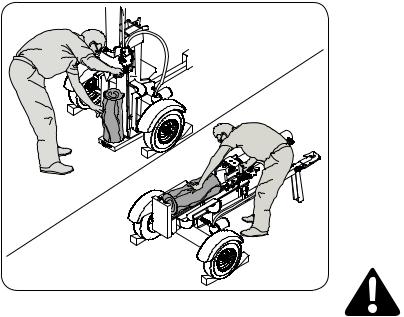
13.If your machine is equipped with an internal combustion engine and is intended for use near any unimproved forest, brush, or grass covered land, the engine exhaust should be equipped with a spark arrestor. Make sure you comply with applicable local, state, and federal codes. Take appropriate firefighting equipment with you.
14.This machine should be used for splitting wood only, do not use it for any other purpose.
15.Follow the instructions in the manual(s) provided with any attachment(s) for this machine.
Preparation
1.Always wear safety shoes or heavy boots.
2.Always wear safety glasses or safety goggles when operating this machine.
3.Never wear jewelry or loose clothing that might become entangled in moving or rotating parts of the machine.
4.Make sure machine is on a flat, dry, solid ground before operating.
5.Always block wheels to prevent unintended movement, and lock beam in either the horizontal or vertical position.
6.Always operate this machine from the operator zone(s) specified in the manual. See Figure 2-1.
Vertical
Horizontal
Figure 2-1
7.Logs should be cut with square ends prior to splitting.
8.Use log splitter in daylight or under good artificial light.
Safe Handling of Gasoline
To avoid personal injury or property damage use extreme care in handling gasoline. Gasoline is extremely flammable and the vapors are explosive. Serious personal injury can occur when gasoline is spilled on yourself or your clothes which can ignite. Wash your skin and change clothes immediately.
a.Use only an approved gasoline container.
b.Extinguish all cigarettes, cigars, pipes, and other sources of ignition.
c.Never fuel machine indoors.
d.Never remove gas cap or add fuel while the engine is hot or running.
e.Allow engine to cool at least two minutes before refueling.
f.Never overfill the fuel tank. Fill tank to no more than 1⁄2-inch below bottom of filler neck to provide space for fuel expansion.
g.Replace gasoline cap and tighten securely.
h.If gasoline is spilled, wipe it off the engine and equipment and move machine to another area. Wait five (5) minutes before starting the engine.
i.Never store the machine or fuel container inside where there is an open flame, spark or pilot light as on a water heater, space heater, furnace, clothes dryer or other gas appliances.
j.Allow machine to cool at least five (5) minutes before storing.
Operation
1.Before starting this machine, review the “Safe Operation Practices”. Failure to follow these rules may result in serious injury to the operator or bystanders.
2.Never leave this machine unattended with the engine running.
3.Do not operate machine while under the influence of alcohol, drugs, or medication.
4.Never allow anyone to operate this machine without proper instruction.
5.Always operate this machine with all safety equipment in place and working. Make sure all controls are operating properly for safe operation.
6.Operator Zone
a.Horizontal Operating Position: Stand on the control lever side of the log splitter and stabilize log as shown, if needed. See Figure 2-1.
b.Vertical Operating Position: Stand in front of the log splitter and stabilize log as shown, if needed. See Figure 2-1.
WARNING! When stabilizing log with left hand, remove your hand when the wedge just contacts the log or serious injury may occur.
7.When loading a log, always place your hands on the side of the log, not on the ends, and never use your foot to help stabilize a log. Failure to do so, may result in crushed or amputated fingers, toes, hand, or foot.
8.Use only your right hand to operate the controls.
9.Never attempt to split more than one log at a time.
10.For logs which are not cut square, the least square end of the log should be placed toward the beam and wedge, and the square end placed toward the end plate.
4 |
|
Section 2 — Important Safe Operation Practices |
|
||
|
|
|

11.When splitting in the vertical position, stabilize the log before moving the control handle. Split as follows:
a.Place log on the end plate and turn until it leans against the beam and is stable.
b.When splitting extra large or uneven logs, the log must be stabilized with wooden shims or split wood placed between the log and end plate or ground.
12.Always keep fingers away from any cracks that open in the log while splitting. They can quickly close and pinch or amputate your fingers.
13.Keep your work area clean. Immediately remove split wood around the machine so you do not stumble over it.
14.Do not change the engine governor settings or overspeed the engine. The governor controls the maximum safe operating speed of the engine.
15.Never move this machine while the engine is running.
16.This machine should not be towed on any street, highway or public road without checking the existing federal, state, or local vehicle requirements. Any licensing or modifications such as taillights, etc., needed to comply, is the sole responsibility of the purchaser. If a “Statement of Origin” is required in your state, see your local dealer.
17.Do not tow machine over 45 mph.
18.See Transporting the Log Splitter section in this manual for proper towing instructions once all federal, local, or state requirements are met.
Maintenance and Storage
1.Stop the engine, disconnect the spark plug and ground it against the engine before cleaning, or inspecting the machine.
2.Stop the engine and relieve hydraulic system pressure by cycling the valve control lever from forward to reverse several times while engine is not running; returning to neutral before repairing or adjusting fittings, hoses, tubing, or other system components.
3.To prevent fires, clean debris and chaff from the engine and muffler areas. If the engine is equipped with a spark arrestor muffler, clean and inspect it regularly according to manufacturers instructions. Replace if damaged.
4.Periodically check that all nuts and bolts, hose clamps, and hydraulic fittings are tight to be sure equipment is in safe working condition.
5.Check all safety guards and shields to be sure they are in the proper position. Never operate with safety guards, shields, or other protective features removed.
6.The pressure relief valve is preset at the factory. Do not adjust the valve.
7.Never attempt to move this machine over hilly or uneven terrain without a tow vehicle or adequate help.
8.For your safety, replace all damaged or worn parts immediately with original equipment manufacturer’s (O.E.M.) parts only. Use of parts which do not meet the original equipment specifications may lead to improper performance and compromise safety!
9.Do not alter this machine in any manner, alterations such as attaching a rope or extension to the control handle, or adding to the width or height of the wedge may result in personal injury.
10.According to the Consumer Products Safety Commission (CPSC) and the U.S. Environmental Protection Agency (EPA), this product has an Average Useful Life of seven (7) years,
or 130 hours of operation. At the end of the Average Useful Life have the machine inspected annually by an authorized service dealer to ensure that all mechanical and safety systems are working properly and not worn excessively. Failure to do so can result in accidents, injuries or death.
Spark Arrestor
WARNING! This machine is equipped with an internal combustion engine and should not be used on or near any unimproved forest-covered, brush covered or grass-covered land unless the engine’s exhaust system is equipped with a spark arrestor meeting applicable local or state laws (if any).
If a spark arrestor is used, it should be maintained in effective working order by the operator. In the State of California the above is required by law (Section 4442 of the California Public Resources Code). Other states may have similar laws. Federal laws apply on federal lands.
A spark arrestor for the muffler is available through your nearest engine authorized service dealer or contact the service department, P.O. Box 361131 Cleveland, Ohio 44136-0019.
Section 2 — Important Safe Operation Practices |
|
5 |
|
||
|
|
|
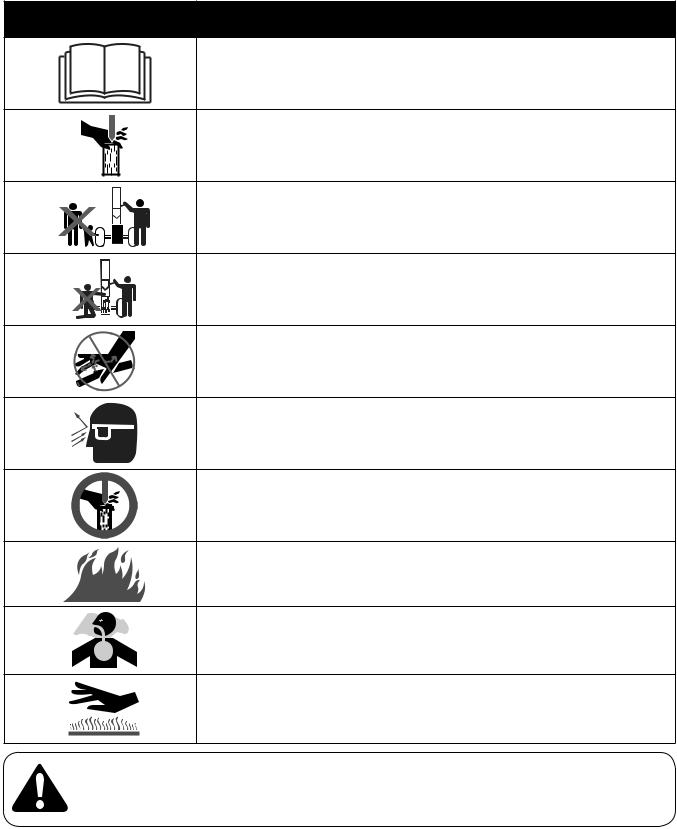
Safety Symbols
This page depicts and describes safety symbols that may appear on this product. Read, understand, and follow all instructions on the machine before attempting to assemble and operate.
Symbol |
Description |
READ THE OPERATOR’S MANUAL(S)
Read, understand, and follow all instructions in the manual(s) before attempting to assemble and operate
WARNING — CRUSHING HAZARD
Keep hands away from wedge, end plate, partially split wood and moving parts.
BYSTANDERS
Keep bystanders, helpers and children at least 10 feet away.
SINGLE OPERATOR
Only one person should operate the machine at a time. The adult who loads and stabilizes the log must be the person who operates control handle.
WARNING — PRESSURIZED FLUID
Never check for hose leaks with your hands. High pressure fluid can escape through a pin hole leak and cause serious injury by puncturing the skin and causing blood poisoning.
EYE PROTECTION
Always wear safety glasses or safety goggles when operating this machine.
WARNING — MOVING WEDGE
Keep hands away from wedge and moving parts.
WARNING—GASOLINE IS FLAMMABLE
Allow the engine to cool at least two minutes before refueling.
WARNING— CARBON MONOXIDE
Never run an engine indoors or in a poorly ventilated area. Engine exhaust contains carbon monoxide, an odorless and deadly gas.
WARNING— HOT SURFACE
Engine parts, especially the muffler, become extremely hot during operation. Allow engine and muffler to cool before touching.
WARNING! Your Responsibility — Restrict the use of this power machine to persons who read, understand and follow the warnings and instructions in this manual and on the machine.
SAVE THESE INSTRUCTIONS!
6 |
|
Section 2 — Important Safe Operation Practices |
|
||
|
|
|
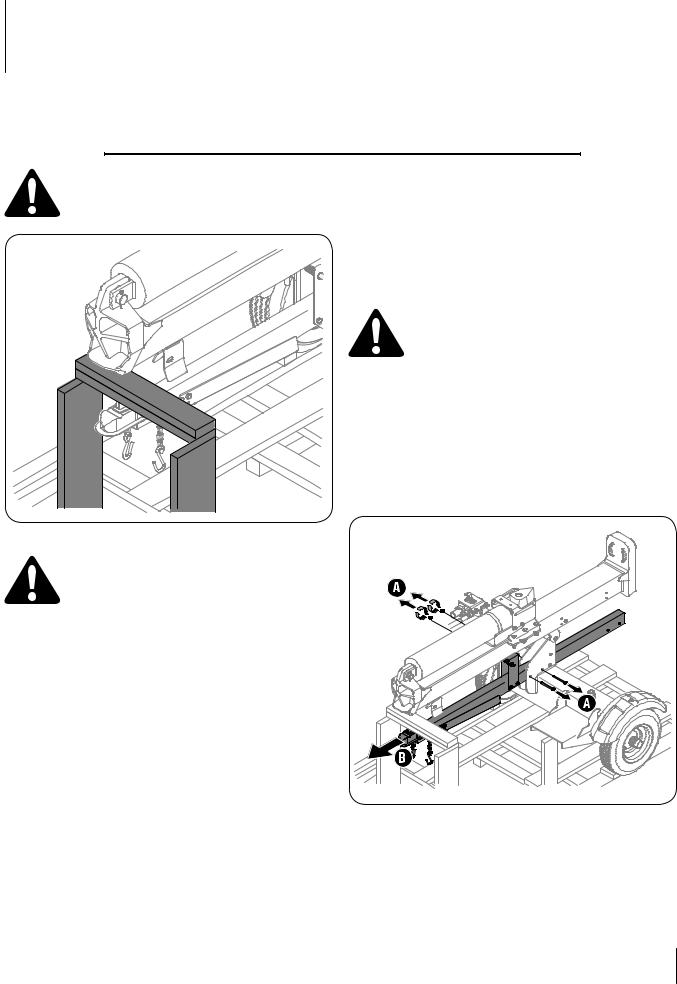
Assembly & Set-Up |
3 |
|
|
Contents of Carton |
|
|
• One Log Splitter • One Operator’s Manual • One Engine Operator’s Manual
WARNING! Do not remove the beam support or attempt to remove the machine from the crate until after you have completed all assembly steps.
See Figure 3-1.
Crate Disassembly
1.Use a pry bar or claw hammer to loosen and remove the top of the crate.
2.Use a pry bar or claw hammer to remove the four sides of the crate, beginning with the short sides (or left and right side of the log splitter). Set the sides of the crate aside to avoid injury.
3.Remove the large plastic cover, if present, and discard.
WARNING! Do NOT remove any supports or cut any straps securing the log splitter to the crate at this time. Only remove straps and/or supports when instructed to do so.
4.Inspect the bottom of the crate for any protruding staples or wood splinters and remove.
5.Remove any loose parts included with the log splitter (e.g. operator’s manual, etc.).
Repositioning the Tongue Tube
For shipping purposes, the tongue tube is secured to the log splitter frame near its center. To reposition it, refer to Figure 3-2 and Figure 3-3 and proceed as follows:
Figure 3-1
WARNING! Use extreme caution when unpacking this machine. It is very heavy and may require additional people to assist in removing the log splitter from the crate.
NOTE: All references in this manual to the left or right side of the log splitter are from the operating position only.
Unpacking & Assembling the Log Splitter
Recommended Tools
•Safety glasses
• Two 9/16-inch wrenches (or adjustable wrenches)
• Leather gloves
•Wire cutters, tin snips or utility knife
•Pry bar and/or claw hammer.
Figure 3-2
1. Remove the two three-inch hex screws and flange nuts securing the tongue tube to the log splitter frame.
2. Carefully slide the tongue tube toward the front of the machine.
7
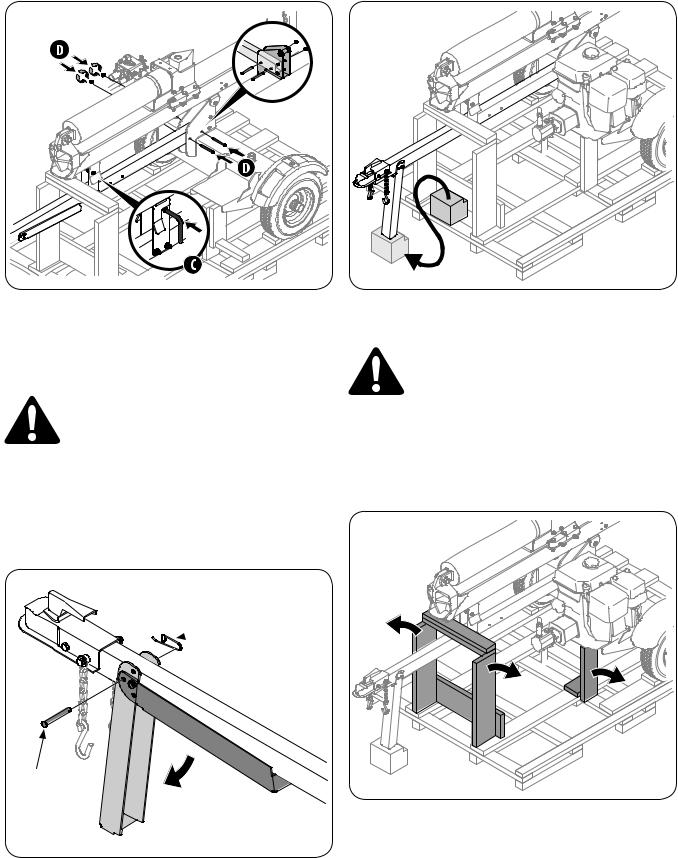
3.Pull the beam lock outward, line it up with the hole in the beam bracket and release the beam lock. See Figure 3-3.
3.Carefully pry the small block of wood from the base of the crate and position it beneath the jack stand. See Figure 3-5.
Figure 3-3
4.Fasten the tongue tube to the frame by reinstalling the two three-inch hex screws removed earlier and tightly securing with the two flange lock nuts. See Figure 3-3.
Positioning the Jack Stand
CAUTION: Do not attempt to move the log splitter off of the crate base until after the jack stand has been positioned downward.
The jack stand is shipped in the transport position. It must be repositioned prior to fully removing the log splitter from the crate.
1.Remove the spring clip and clevis pin and pivot the jack stand toward the ground, into the operating position.
2.Secure the jack stand in position with the clevis pin and the spring clip. See. Figure 3-4.
 Spring Clip
Spring Clip
Clevis Pin
Figure 3-4
Figure 3-5
Removing the Supports
CAUTION: Do not attempt to move the log splitter off of the crate base until after the crate supports and plastic tie-straps have been removed.
There are three tie-straps securing the log splitter to the crate, one on the beam support and one on each side of the reservoir tank, near each fender. There are also two supports found on the log splitter crate, one beneath the engine and one beneath the beam. Carefully cut and discard each tie-strap and remove and discard each support. See Figure 3-6.
Figure 3-6
NOTE: The jack stand, repositioned in the previous step, will support the weight of the log splitter with the supports removed.
8 |
|
Section 3— Assembly & Set-Up |
|
||
|
|
|

4.Carefully reposition the log splitter off of the crate by lifting up on the tongue tube, near the hitch coupling, and slowly rotating the machine clockwise. See Figure 3-7.
Set-Up
Gas and Oil Fill-Up
Service the engine with gasoline and oil as instructed in the engine manual packed with your log splitter. Read the instructions carefully.
WARNING! Use extreme care when handling gasoline. Gasoline is extremely flammable and the vapors are explosive. Never fuel the machine indoors or while the engine is hot or running.
NOTE: Your log splitter is shipped with motor oil in the engine. You MUST check the oil level before operating. Be careful not to overfill. Gasoline can be added to the engine when the log splitter is in either the horizontal or vertical position. However, it may be easier when the splitter is in the vertical position.
Preparing the Log Splitter
1.Lubricate the beam area (where the splitting wedge will slide) with engine oil. Do not use grease.
2.Remove the vented reservoir dipstick, which is located in front of the engine on top of the reservoir tank. See Figure 3-9.
Figure 3-7
Repositioning the Control Handle
The control handle is shipped hanging from the valve on the handle link.
1.Remove the clevis pin and bow-tie cotter pin from the control handle. See Figure 3-8.
Control Handle
Bow-Tie |
Clevis |
|
Cotter |
||
Pin |
||
Pin |
||
|
Figure 3-8
2.Rotate the control handle into the operating position and secure with the clevis pin and bow-tie cotter pin removed in step 1. See Figure 3-8.
Figure 3-9
NOTE: The log splitter is filled to the proper operating level from the manufacturer with Shell Tellus® S2 M 32 Hydraulic Fluid. However, you MUST check the fluid level before operating. If not filled, proceed with the following steps:
CAUTION: Much of the original fluid has been drawn into the cylinder and hoses. Make certain to refill the reservoir to prevent damage to the hydraulic pump.
3.Check the fluid level using the dipstick. See Figure 3-9. Do not overfill.
NOTE: Approved fluids include Shell Tellus® S2 M 32 Hydraulic Fluid, Dexron® III/Mercon® automatic
transmission fluid, Pro-Select™ AW-32 Hydraulic Oil or 10WAW-ISO viscosity grade 32 hydraulic oil. It is not recommended that fluids be mixed, to top off the reservoir tank during initial set-up use Shell Tellus® S2 M 32 Hydraulic Fluid only.
Section 3 — Assembly & Set-Up |
|
9 |
|
||
|
|
|

4.Replace the vented dipstick securely, tightening it until the top of the threads are flush with top of the pipe.
5.Disconnect the spark plug and prime the pump by pulling the recoil starter as far as it will go. Repeat approximately 10 times.
6.Reconnect the spark plug wire and start the engine following instructions in the Engine Operator’s manual.
7.Use the control handle to engage the wedge to the farthest extended position. Then retract the wedge.
8.Refill the tank as specified on the dipstick if necessary
NOTE: Failure to refill the tank will void the splitter’s warranty.
9.Extend and retract the wedge 12 complete cycles to remove any trapped air in the system (the system is “selfbleeding”).
10.Refill the reservoir within the range marked on the dipstick if necessary.
NOTE: Some fluid may overflow from the vent plug as the system builds heat and the fluid expands and seeks a balanced level.
Tire Pressure
The max recommended operating pressure is 30 psi. Do not under any circumstances exceed the manufacturer’s recommended psi. Maintain equal pressure in both tires.
WARNING! Excessive pressure when seating beads may cause tire/rim assembly to burst with force sufficient to cause serious injury.
10 Section 3— Assembly & Set-Up
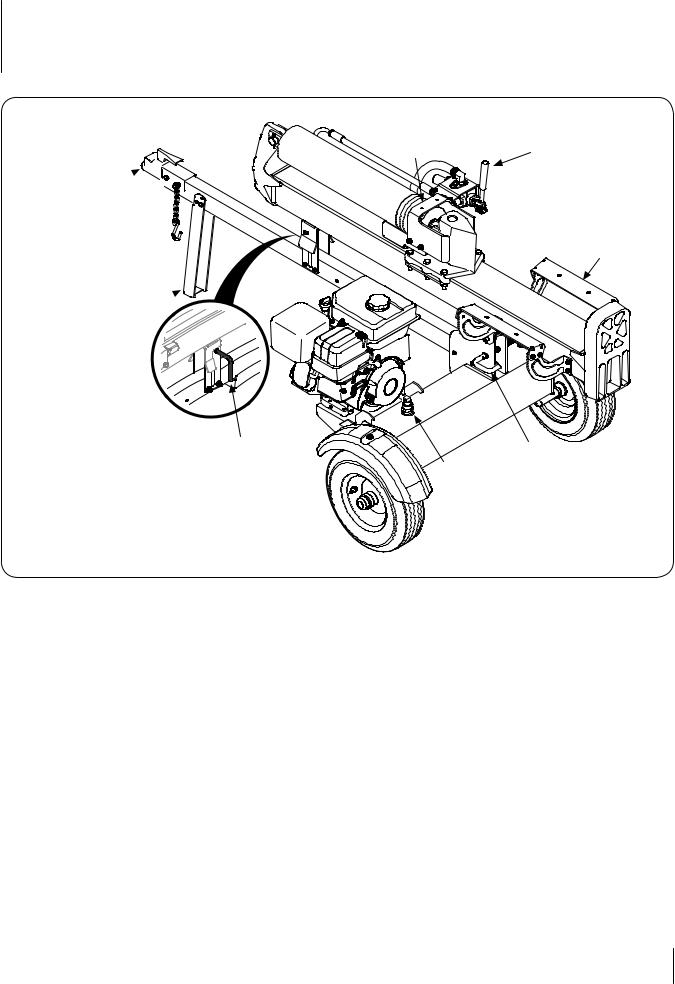
Controls & Features |
4 |
|
|
|
|
Log Dislodger |
Control Handle |
Hitch Coupling

Log Tray
Jack Stand 
Horizontal |
Vertical |
|
Beam Lock |
||
Beam Lock |
||
Dipstick |
Engine Controls
See the Engine Operator’s Manual for the location and function of the controls on the engine.
Beam Locks
The beam locks are used to secure the beam in either the horizontal position or the vertical position. The vertical beam lock is located next to the engine. The horizontal beam lock is located on the beam support latch bracket.
Control Handle
Use the control handle to move the log splitter wedge forward and backward along the beam. It has three positions; Forward, Neutral and Reverse. See the Operation section for instructions.
Dipstick
Use the dipstick to check the hydraulic fluid level.
Log Dislodger
The log dislodger is designed to remove any partially split wood from the wedge while it is retracting. This may occur while splitting large diameter wood or freshly cut wood.
Log Tray
The log tray is designed to catch the log after it is split.
Hitch Coupling
Use the hitch coupling to attach the log splitter to a towing vehicle for transportation.
Jack Stand
The jack stand supports the log splitter while in the operating position.
11
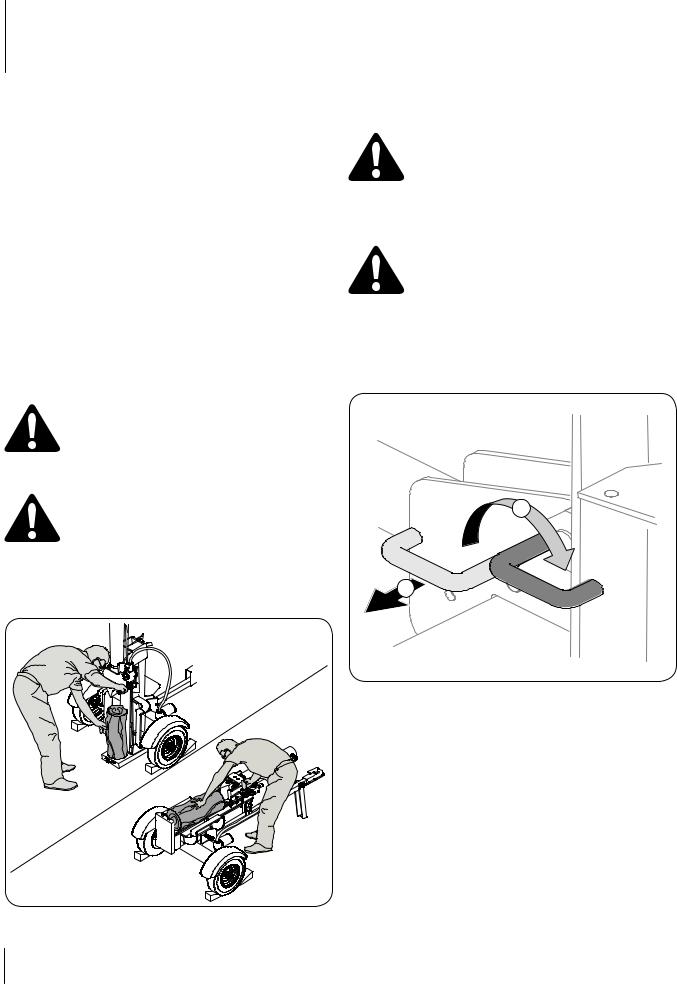
Operation |
5 |
|
|
|
|
Pre-Start Checklist
1.Remove the dipstick and check hydraulic fluid level. Refill if necessary. Approved fluids include Shell Tellus® S2 M 32 Hydraulic Fluid, Dexron® III / Mercon® automatic transmission fluid, Pro-Select™ AW-32 Hydraulic Oil or 10WAW-ISO viscosity grade 32 hydraulic oil. Check the engine oil level. Refill if necessary.
2.Check the engine oil level. Refill if necessary.
3.Fill up with gasoline if necessary.
4.Lubricate the beam area where the splitting wedge will slide with engine oil. Do not use grease to lubricate. Make sure to lubricate both the front and the back of the beam face.
5.Attach the spark plug wire to the spark plug.
Starting the Engine
Please refer to the separately included engine operator’s manual for detailed starting instructions.
WARNING! Read, understand and follow all the instructions and warnings on the machine and in this and the included Engine Operator’s Manual before operating.
Using the Log Splitter
WARNING! Wear leather work gloves, safety shoes, ear protection and safety glasses when operating
the log splitter. Ensure safe footing.
Operating Positions
1.Place the log splitter on flat, dry, solid ground.
2.Block the front and back of both wheels. See Figure 5-1.
Vertical
Horizontal
Figure 5-1
3.Place the beam in either the horizontal or vertical position and lock into place.
WARNING! Take extra care when raising and lowering the beam as it is fairly heavy. Having a second person assist with raising or lowering the beam is recommended. Be sure to keep hands away from any possible pinch points.
4.To place the beam in the Vertical Position proceed as follows:
WARNING! Always use the log splitter in the vertical position when splitting heavy logs.
a.Pull the horizontal beam lock out to release the beam and pivot the beam to the vertical position.
b.To lock the beam in the vertical position, pull out on the vertical beam lock and rotate it to secure the beam. See Figure 5-2.
2
1
Vertical Beam Lock
Figure 5-2
12
